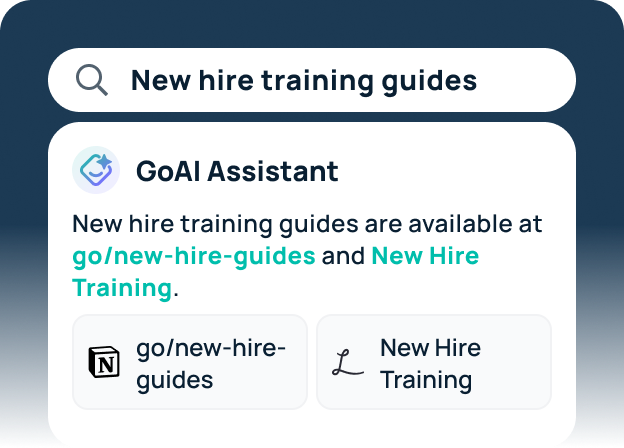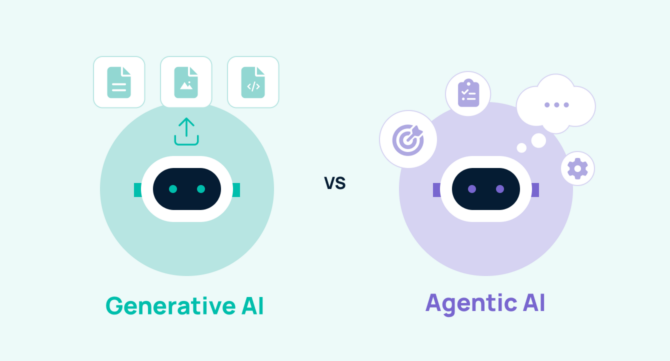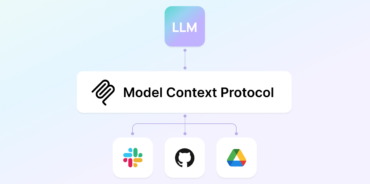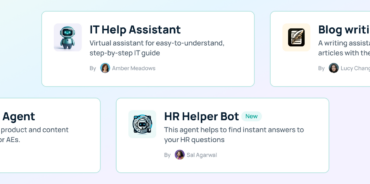As artificial intelligence (AI) continues to evolve, two key paradigms have emerged: agentic AI vs generative AI. These models represent distinct approaches to AI functionality, each serving unique purposes in enterprise and consumer applications. Understanding the differences between agentic AI and generative AI is crucial for businesses looking to leverage AI effectively. In this blog, we’ll explore these two AI models, their use cases, and how GoSearch, an enterprise search platform, integrates both to enhance productivity and decision-making.
What Is Generative AI?
Generative AI is designed to create content. It excels at generating text, images, audio, and even code based on patterns learned from vast datasets. Popular models include OpenAI’s ChatGPT and DALL·E, and Google’s Bard. These models use deep learning techniques, particularly transformer-based neural networks, to generate human-like responses and creative outputs.
Key Characteristics:
- Content Creation: Generates new text, images, or other media types.
- Pattern Recognition: Learns from existing datasets to produce relevant and coherent outputs.
- Conversational Abilities: Can engage in human-like dialogue, making it valuable for chatbots, marketing, and creative applications.
- Limited Autonomy: While generative AI can produce intelligent responses, it does not independently decide or act beyond its given instructions.
Use Cases:
- Content generation for marketing, blogs, and social media.
- Customer support chatbots that provide automated responses.
- Design assistance in generating images, layouts, and creative assets.
- Code generation to help developers automate repetitive programming tasks.
What Is Agentic AI?
Agentic AI, on the other hand, goes beyond content generation to actively plan, execute, and adapt based on goals. Instead of passively responding to prompts, agentic AI operates with a degree of autonomy, making decisions and taking actions to complete complex workflows.
Key Characteristics:
- Goal-Oriented: Works towards achieving specific objectives autonomously.
- Decision-Making Abilities: Evaluates multiple options and selects the best course of action.
- Process Automation: Can handle multi-step workflows with minimal human intervention.
- Adaptive Learning: Continuously refines its approach based on new data and feedback.
Use Cases:
- Enterprise automation, streamlining business operations such as HR, finance, and IT workflows.
- AI-driven project management that autonomously assigns and tracks tasks.
- Supply chain optimization, making real-time decisions to adjust logistics and inventory.
- Cybersecurity threat detection that actively responds to security breaches.
Agentic AI vs. Generative AI: Key Differences
| Feature | Generative AI | Agentic AI |
| Primary Function | Creates content (text, images, code, etc.) | Takes action and makes decisions |
| Autonomy | Limited to generating responses based on input | Can operate independently to complete tasks |
| Intelligence | Predictive and pattern-based | Goal-driven and adaptive |
| Common Use Cases | Writing, design, chatbots, code generation | Workflow automation, decision support, security monitoring |
| Interaction Style | Requires human prompts for output | Can act proactively based on predefined goals |
While both generative AI and agentic AI have valuable applications, businesses that require intelligent automation and strategic decision-making will benefit most from agentic AI, whereas those focusing on content creation and engagement will find generative AI more useful.
How GoSearch Combines Agentic and Generative AI for Enterprise Search
GoSearch harnesses the power of both agentic AI and generative AI to deliver an unparalleled enterprise search experience for businesses. Employees today spend significant time searching for information across multiple platforms—an inefficiency GoSearch eliminates through AI-driven intelligence.
Generative AI in GoSearch:
GoSearch leverages generative AI to provide:
- Summarized Answers: Instead of surfacing a long list of links, GoSearch generates concise, contextual answers to employee queries.
- Conversational Search: Users can interact with GoSearch using natural language, receiving AI-crafted responses tailored to their specific needs.
- Enhanced Knowledge Retrieval: By synthesizing information from multiple sources, GoSearch provides a comprehensive understanding of company knowledge.
Agentic AI in GoSearch:
On the agentic AI front, GoSearch is designed to proactively assist users by:
- Smart Recommendations: GoSearch suggests relevant documents, insights, and next steps based on user behavior and organizational priorities.
- Automating Workflows: Agents can execute searches, retrieve data, and integrate with enterprise tools to complete tasks autonomously.
By combining agentic AI’s decision-making capabilities with generative AI’s content generation strengths, GoSearch offers a truly intelligent enterprise search solution that minimizes information overload and maximizes productivity.
The Future of AI: Agentic and Generative AI Working Together
The future of AI isn’t about choosing between agentic and generative models—it’s about leveraging both where they shine. Organizations that integrate both paradigms will benefit from AI that not only creates valuable content but also takes intelligent actions to optimize workflows and decision-making.
GoSearch is a prime example of how businesses can harness the strengths of agentic AI and generative AI to enhance efficiency, collaboration, and knowledge management. As AI technology continues to evolve, enterprises that adopt this dual approach will gain a significant competitive advantage in the digital age.
Looking to transform how your organization finds and acts on information? Explore how GoSearch can revolutionize enterprise search with the power of AI.
Search across all your apps for instant AI answers with GoSearch
Schedule a demo

















